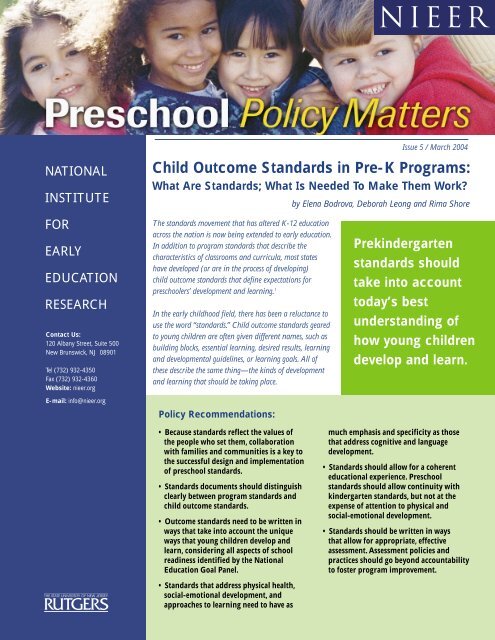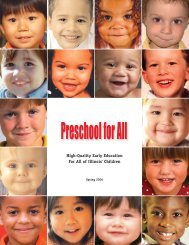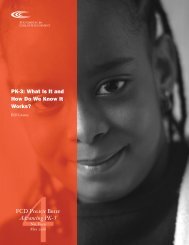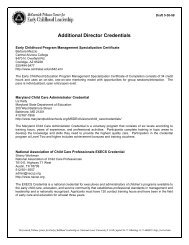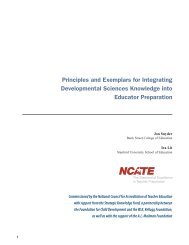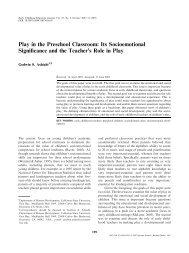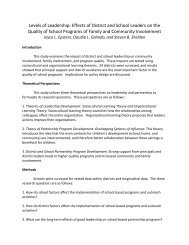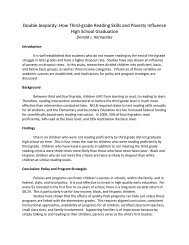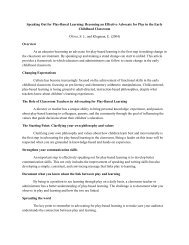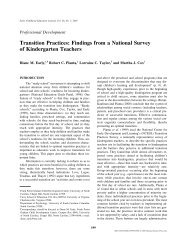Child Outcome Standards in Pre-K Programs - National Institute for ...
Child Outcome Standards in Pre-K Programs - National Institute for ...
Child Outcome Standards in Pre-K Programs - National Institute for ...
You also want an ePaper? Increase the reach of your titles
YUMPU automatically turns print PDFs into web optimized ePapers that Google loves.
Issue 5 / March 2004NATIONALINSTITUTE<strong>Child</strong> <strong>Outcome</strong> <strong>Standards</strong> <strong>in</strong> <strong>Pre</strong>-K <strong>Programs</strong>:What Are <strong>Standards</strong>; What Is Needed To Make Them Work?by Elena Bodrova, Deborah Leong and Rima ShoreFOREARLYEDUCATIONRESEARCHContact Us:120 Albany Street, Suite 500New Brunswick, NJ 08901Tel (732) 932-4350Fax (732) 932-4360Website: nieer.orgE-mail: <strong>in</strong>fo@nieer.orgThe standards movement that has altered K-12 educationacross the nation is now be<strong>in</strong>g extended to early education.In addition to program standards that describe thecharacteristics of classrooms and curricula, most stateshave developed (or are <strong>in</strong> the process of develop<strong>in</strong>g)child outcome standards that def<strong>in</strong>e expectations <strong>for</strong>preschoolers’ development and learn<strong>in</strong>g. 1In the early childhood field, there has been a reluctance touse the word “standards.” <strong>Child</strong> outcome standards gearedto young children are often given different names, such asbuild<strong>in</strong>g blocks, essential learn<strong>in</strong>g, desired results, learn<strong>in</strong>gand developmental guidel<strong>in</strong>es, or learn<strong>in</strong>g goals. All ofthese describe the same th<strong>in</strong>g—the k<strong>in</strong>ds of developmentand learn<strong>in</strong>g that should be tak<strong>in</strong>g place.Policy Recommendations:<strong>Pre</strong>k<strong>in</strong>dergartenstandards shouldtake <strong>in</strong>to accounttoday’s bestunderstand<strong>in</strong>g ofhow young childrendevelop and learn.• Because standards reflect the values ofthe people who set them, collaborationwith families and communities is a key tothe successful design and implementationof preschool standards.• <strong>Standards</strong> documents should dist<strong>in</strong>guishclearly between program standards andchild outcome standards.• <strong>Outcome</strong> standards need to be written <strong>in</strong>ways that take <strong>in</strong>to account the uniqueways that young children develop andlearn, consider<strong>in</strong>g all aspects of schoolread<strong>in</strong>ess identified by the <strong>National</strong>Education Goal Panel.much emphasis and specificity as thosethat address cognitive and languagedevelopment.• <strong>Standards</strong> should allow <strong>for</strong> a coherenteducational experience. <strong>Pre</strong>schoolstandards should allow cont<strong>in</strong>uity withk<strong>in</strong>dergarten standards, but not at theexpense of attention to physical andsocial-emotional development.• <strong>Standards</strong> should be written <strong>in</strong> waysthat allow <strong>for</strong> appropriate, effectiveassessment. Assessment policies andpractices should go beyond accountabilityto foster program improvement.1• <strong>Standards</strong> that address physical health,social-emotional development, andapproaches to learn<strong>in</strong>g need to have as
<strong>Pre</strong>school Policy Brief March 2004What Are <strong>Standards</strong>?In the realm of early education,it is important to dist<strong>in</strong>guish amongdifferent k<strong>in</strong>ds of standards.Program <strong>Standards</strong> describe theresources, activities, and <strong>in</strong>structionprograms offer to help children learn.Program standards <strong>in</strong>corporate both:• Classroom <strong>Standards</strong> thatidentify classroom characteristicssuch as the maximum number ofchildren <strong>in</strong> a classroom; the allowableratio of adults to children; and thematerials and supports available tochildren and families.• Teach<strong>in</strong>g and Curriculum<strong>Standards</strong> that are sometimesdescribed as opportunities to learn(e.g., “children are exposed to varioustypes of age-appropriate literature”or “educational experiences willensure that children pr<strong>in</strong>t or copytheir first name”) or activities (e.g.,“children listen to traditional tales”).While program standards may<strong>in</strong>fluence what teachers do, theyare generally <strong>in</strong>tended to guideadm<strong>in</strong>istrators.<strong>Child</strong> <strong>Outcome</strong> <strong>Standards</strong>describe the knowledge and skillschildren should acquire by the endof the year. Comprehensive childoutcome standards encompass:• Content <strong>Standards</strong> that def<strong>in</strong>ethe range of knowledge and skillsthat children should master. Theycan also extend beyond knowledgeand skills, describ<strong>in</strong>g the k<strong>in</strong>ds ofhabits, attitudes, and dispositionsstudents are expected to developas a result of classroom experiences.For example, content standardscan address self-efficacy or empathy.• Per<strong>for</strong>mance <strong>Standards</strong> thatdescribe how it can be demonstratedthat children have met the contentstandards.Readers may want to consult the jo<strong>in</strong>tposition statement on early learn<strong>in</strong>gstandards issued <strong>in</strong> 2002 by the <strong>National</strong>Association <strong>for</strong> the Education of Young<strong>Child</strong>ren (NAEYC) and the <strong>National</strong>Association of Early <strong>Child</strong>hoodSpecialists <strong>in</strong> State Departments ofEducation(NAECS/SDE).2This Policy Brief:• Provides an overview of how thestandards movement is be<strong>in</strong>gextended to preschool programs;• Describes child outcomes standards<strong>in</strong> relation to other types of standardsand quality <strong>in</strong>dicators;• Offers an overview of the conditionsneeded <strong>for</strong> standards to work; and• Describes the special considerationsthat must be taken <strong>in</strong>to account ifchild outcome standards are tohave a positive impact on preschoolchildren and programs.Focus<strong>in</strong>g on ResultsA quarter century ago, only a handfulof states <strong>in</strong>vested <strong>in</strong> early education.Today, four out of five states runpreschool programs, and several aremov<strong>in</strong>g toward public provision ofprograms <strong>for</strong> all 4-year-olds whoseparents want to enroll them.<strong>Pre</strong>school <strong>for</strong> all is a powerful visionthat can create fundamental change<strong>in</strong> American education. Like themovement that resulted <strong>in</strong> publick<strong>in</strong>dergarten <strong>for</strong> 5-year-olds,preschool <strong>for</strong> all requires broad publicsupport. Recent history suggests thatsuch support can be won. The case <strong>for</strong>public <strong>in</strong>vestment <strong>in</strong> early educationhas been strengthened by evidencethat preschool programs can boostschool read<strong>in</strong>ess <strong>in</strong> the short run and,<strong>in</strong> the long run, improve graduationrates, <strong>in</strong>crease adult earn<strong>in</strong>gs, andlower crime rates. 2But there is a catch. These benefitsaccrue only from high-qualityprograms. Cont<strong>in</strong>ued support <strong>for</strong>public <strong>in</strong>vestment <strong>in</strong> early educationh<strong>in</strong>ges on educators’ ability todemonstrate results. As the presidentof the High/Scope EducationalResearch Foundation, Lawrence J.Schwe<strong>in</strong>hart, has written, preschool<strong>for</strong> all “constitute[s] an extraord<strong>in</strong>aryvision. Without a focus on highstandards of quality, however, thisvision is but an empty promise.” 3Today, there is grow<strong>in</strong>g consensuson the part of educators and publicpolicy makers that program standardsshould <strong>in</strong>clude child outcomes – whatchildren should know and be able todo after participat<strong>in</strong>g <strong>in</strong> preschoolprograms.
<strong>Pre</strong>school Policy Brief March 2004Extend<strong>in</strong>g <strong>Outcome</strong> <strong>Standards</strong>to the <strong>Pre</strong>school Years<strong>Outcome</strong> standards are a relativelyrecent phenomenon <strong>in</strong> Americaneducation. For most of our nation’shistory, parents and school boardslacked the systematic assessment<strong>in</strong><strong>for</strong>mation needed to gauge children’sprogress and the effectivenessof schools. There was little agreementon what children should know andbe able to do. In recent decades,accountability took on new mean<strong>in</strong>g.State agencies and professional organizationshave engaged <strong>in</strong> major ef<strong>for</strong>tsto def<strong>in</strong>e, with some precision, theknowledge and skills that students areexpected to master at each grade leveland <strong>in</strong> each subject area. Curriculaand assessments have been alignedwith these standards. And <strong>in</strong> manycases, schools and pr<strong>in</strong>cipals havebeen rated on the basis of theirability to meet the standards.Researchers say that the ef<strong>for</strong>t hasbegun to pay off. Today, ef<strong>for</strong>ts areunderway to extend that successto preschool programs. 4 The idea isto use standards to improve the oddsthat preschool programs willboost school read<strong>in</strong>ess and laya solid foundation <strong>for</strong> laterachievement.The idea rema<strong>in</strong>s controversial,however. After all, from thestandpo<strong>in</strong>t of development, 3-and 4-year-olds are differentfrom older children. <strong>Pre</strong>schoolersare actively engaged <strong>in</strong> mak<strong>in</strong>gsense of their worlds, but they havenot yet developed the strategies <strong>for</strong>process<strong>in</strong>g <strong>in</strong><strong>for</strong>mation, remember<strong>in</strong>g,and solv<strong>in</strong>g problems that mostolder children take <strong>for</strong> granted.For example, accord<strong>in</strong>g to the<strong>National</strong> Research Council, 3- and 4-year-olds are just beg<strong>in</strong>n<strong>in</strong>g to understandthe need to use strategic ef<strong>for</strong>t<strong>in</strong> order to learn. 5All children learn <strong>in</strong> the context ofimportant relationships, but <strong>in</strong> thepreschool years children’s learn<strong>in</strong>gis especially <strong>in</strong>fluenced by the social<strong>in</strong>teractions they experience, whetherat home or <strong>in</strong> other sett<strong>in</strong>gs. Scientistssay that young children’s capacities aredecisively <strong>in</strong>fluenced by their environmentsand the people who care <strong>for</strong>them. “<strong>Child</strong>ren’s curiosity andpersistence are supported by adultswho direct their attention, structuretheir experiences, support theirlearn<strong>in</strong>g attempts, and regulate thecomplexity and difficulty levels of<strong>in</strong><strong>for</strong>mation <strong>for</strong> them.” 6How can standards take <strong>in</strong>to accountthese and other f<strong>in</strong>d<strong>in</strong>gs about thedevelopment and learn<strong>in</strong>g of youngchildren? How is it possible to def<strong>in</strong>ereasonable developmental milestones,assess them appropriately, and usethe <strong>in</strong><strong>for</strong>mation toimprove plann<strong>in</strong>g,classroompedagogy, andprogramevaluation?The Impact of K-12<strong>Standards</strong><strong>Standards</strong>-based re<strong>for</strong>m is a comprehensiveapproach that has <strong>in</strong>fluenced manyareas of education. 7 Accord<strong>in</strong>g to datacollected by the Education Commissionof States, “states that have focused onalign<strong>in</strong>g various components of theireducation system with standards haveshown improvement <strong>in</strong> student achievementand school quality.” 8Similar f<strong>in</strong>d<strong>in</strong>gs were reported <strong>in</strong> thenewly released longitud<strong>in</strong>al study ofat-risk children <strong>in</strong> Title 1 schools.The study found that, “students’ <strong>in</strong>itialread<strong>in</strong>g scores tended to be higher <strong>in</strong>classrooms where teachers reported theywere aware of, and implement<strong>in</strong>g,policies of standards-based re<strong>for</strong>m.” 9Given these f<strong>in</strong>d<strong>in</strong>gs, educators andparents may expect an emphasis on earlylearn<strong>in</strong>g standards to produce similarimprovements <strong>in</strong> the quality of earlychildhood programs. However, ananalysis of exist<strong>in</strong>g pre-K standardsdocuments 10 and a review of thestandards movement <strong>in</strong> general<strong>in</strong>dicate that the impact ofstandards depends upon arange of conditions, <strong>in</strong>clud<strong>in</strong>gthe policy and implementationissues addressed <strong>in</strong> these pages.3
<strong>Pre</strong>school Policy Brief March 2004N<strong>in</strong>e Keys to Effective <strong>Pre</strong>k<strong>in</strong>dergarten <strong>Standards</strong>Many of the conditions needed <strong>for</strong> successful standards-based re<strong>for</strong>m apply to all grade levels, <strong>in</strong>clud<strong>in</strong>g prek<strong>in</strong>dergarten.This section describes n<strong>in</strong>e keys to effective standards. For each, it addresses the particular considerations or conditionsthat must be addressed to make child outcome standards appropriate and effective <strong>in</strong> the preschool years.1<strong>Standards</strong> should represent values that make senseto children’s families and communities.<strong>Standards</strong> identify the knowledge and skills that teachersshould spend the most time on. They def<strong>in</strong>e not only sharedexpectations, but also shared notions about what matters <strong>for</strong>children. 6 In this way, standards represent the values of thepeople who set them. 3For preschoolers… When young children are <strong>in</strong>volved,families and communities tend to be especially concernedabout the values that underlie outcome standards. After all,it is dur<strong>in</strong>g the early years that children beg<strong>in</strong> to developempathy and understand basic moral precepts. It is dur<strong>in</strong>gthe preschool years that children <strong>for</strong>m the secure relationshipswith adults that allow them to venture off and explore; beg<strong>in</strong>to <strong>in</strong>teract cooperatively with peers; and slowly <strong>in</strong>crease theircapacity <strong>for</strong> self-regulation. Early childhood programsthere<strong>for</strong>e track children’s progress across the developmentalspectrum, <strong>in</strong>clud<strong>in</strong>g the very important social and emotionaldoma<strong>in</strong>s. Expectations of children tend to reflect deeply heldassumptions and values. It is there<strong>for</strong>e especially important toengage families and communities <strong>in</strong> discussions that help toshape preschool standards.What Young <strong>Child</strong>ren Know& Can Do“Armed with new methodologies, psychologists began toaccumulate a substantial body of ideas about the remarkableabilities that young children possess that stands <strong>in</strong> starkcontrast to the older emphases on what they lacked. It isnow known that very young children are competent,active agents of their own conceptual development...”“Young children are actively engaged <strong>in</strong> mak<strong>in</strong>g senseof their worlds. In some particular doma<strong>in</strong>s, such asbiological and physical causality, number, and language,they have strong predispositions to learn rapidly andreadily. These predispositions support and may evenmake possible early learn<strong>in</strong>g and pave the way <strong>for</strong>competence <strong>in</strong> early school<strong>in</strong>g.”2<strong>Standards</strong> should be evidence-based.<strong>Standards</strong> are sets of detailed explanations and illustrations ofwhat children should know and be able to do <strong>in</strong> a particulararea, by a specific time <strong>in</strong> a child’s education. <strong>Standards</strong> needto be evidence-based. That is, they need to be based on thebest evidence of what young children can learn. 11In addition, they should be based on research show<strong>in</strong>g thatparticular outcome standards, implemented as part of thecurriculum and ongo<strong>in</strong>g teach<strong>in</strong>g and assessment, cancontribute to positive outcomes <strong>for</strong> the children <strong>for</strong> whomthey are <strong>in</strong>tended.For preschoolers… Research has shown that youngchildren are more capable than was once thought. 12Psychologists and cognitive scientists have shown thatpreschoolers are active learners who are predisposed tocerta<strong>in</strong> k<strong>in</strong>ds of knowledge. But <strong>in</strong> many areas there is notenough evidence to identify reasonable expectations <strong>for</strong> youngchildren. Research is particularly th<strong>in</strong> <strong>in</strong> relation to standards<strong>for</strong> children with disabilities and other special needs.In the absence of such research, exist<strong>in</strong>g sets of pre-Kstandards rely on the practical experience of early childhoodeducators and the academiccontent taught <strong>in</strong> higher grades.In many cases, these twoperspectives are not properlybalanced, result<strong>in</strong>g <strong>in</strong>standards that eitherunderestimate oroverestimate thelearn<strong>in</strong>g potentialof young children.4<strong>National</strong> Research Council, How People Learn: Bra<strong>in</strong>,M<strong>in</strong>d, Experience, and School, 1999.
<strong>Pre</strong>school Policy Brief March 2004How Many <strong>Standards</strong>?One of the criticisms of K-12 standards has been the sheernumber of standards and benchmarks. Accord<strong>in</strong>g to aconservative estimate, it takes an average of five hours tocover one content benchmark. Address<strong>in</strong>g all standards andbenchmarks identified by states and districts would requireK-12 systems to become K-22 systems! 17Early childhood educators and policy makers should identifya reasonable set of expectations and outcomes that aremean<strong>in</strong>gful and represent the critical learn<strong>in</strong>g necessary<strong>for</strong> later development.3<strong>Standards</strong> should be comprehensive.<strong>Standards</strong> should cover the full range of knowledge, skills,habits, attitudes, and dispositions that children need tomaster. They should encompass all of the major branchesof knowledge that contribute to children’s capacity toreason, create, communicate, solve problems, and ma<strong>in</strong>ta<strong>in</strong>their health. 13 Comprehensive standards <strong>in</strong>clude contentstandards (def<strong>in</strong><strong>in</strong>g the range of knowledge and skillsthat children should master) and per<strong>for</strong>mance standards(def<strong>in</strong><strong>in</strong>g how it can be demonstrated that children havemet the standards).For preschoolers… To be comprehensive, outcomestandards must take <strong>in</strong>to account the five doma<strong>in</strong>s of schoolread<strong>in</strong>ess identified by the <strong>National</strong> Education Goals Panel. 14,1• Physical well-be<strong>in</strong>g and motor development• Social and emotional development• Approaches toward learn<strong>in</strong>g• Language development• Cognitive and general knowledgeYoung children’s learn<strong>in</strong>g is heavily dependent on thedevelopment of language, th<strong>in</strong>k<strong>in</strong>g, and cognitive andsocio-emotional skills that are taken <strong>for</strong> granted <strong>in</strong> highergrades where the primary emphasis is placed on content.In early childhood, the development of these foundationalskills (skills that lay the foundation <strong>for</strong> later learn<strong>in</strong>g) is justas important as mastery of content matter. For example,there is a grow<strong>in</strong>g body of evidence <strong>in</strong>dicat<strong>in</strong>g that cognitiveand emotional self-regulation play a key role <strong>in</strong> <strong>in</strong>fluenc<strong>in</strong>grates of learn<strong>in</strong>g and school read<strong>in</strong>ess. 15,16 For preschoolers,standards that address foundational skills should there<strong>for</strong>ebe articulated with as much specificity as the contentstandards.4<strong>Standards</strong> should be specific, yet still allowflexibility as teachers implement them.If a standard covers a broad area of learn<strong>in</strong>g or developmentit must to be broken down <strong>in</strong>to more narrow benchmarks.However, the benchmarks should not be too specificto allow <strong>for</strong> teachers’ flexibility <strong>in</strong> implement<strong>in</strong>g differentcurricula or us<strong>in</strong>g different <strong>in</strong>structional strategies. Forexample, a benchmark that says: “retells from memory afamiliar book about farm animals” appears overly specific.For preschoolers… In some areas, the lack of specificitythat can weaken standards <strong>for</strong> older students can alsounderm<strong>in</strong>e preschool standards. There is a particularlystrong need <strong>for</strong> specificity as standards and benchmarksare written <strong>for</strong> preschool language and literacy development.18 As one recent study observed, “age appropriate andwell-written clear benchmarks have a crucial role <strong>in</strong> br<strong>in</strong>g<strong>in</strong>geffective literacy practices to preschool programs.” 19<strong>Pre</strong>school outcomes need to be stated <strong>in</strong> terms of skills,rather than activities.In other areas of early learn<strong>in</strong>g, the requirement of specificitycan be problematic because many of young children’s competenciesare develop<strong>in</strong>g <strong>in</strong> concert. It is often difficult toisolate learn<strong>in</strong>g outcomes <strong>in</strong> a s<strong>in</strong>gle area. It is often betterto describe a learn<strong>in</strong>g outcome <strong>in</strong> a way that is specific to aparticular doma<strong>in</strong> of development, even if that meansrepeat<strong>in</strong>g the standard (perhaps with different emphasis)as it relates to another doma<strong>in</strong>. This will help teachers tobetter focus on the outcome of a child’s learn<strong>in</strong>g <strong>in</strong>choos<strong>in</strong>g appropriate assessments, materials and activities.For example, while be<strong>in</strong>g able to participate <strong>in</strong> dramaticplay is a learn<strong>in</strong>g outcome that comb<strong>in</strong>es a young child’sachievements <strong>in</strong> the areas of socio-emotional, cognitive,and language development, support<strong>in</strong>g each of these areaspresents teachers with different demands <strong>in</strong> terms ofassess<strong>in</strong>g child per<strong>for</strong>mance or plann<strong>in</strong>g <strong>in</strong>structional<strong>in</strong>terventions.What Are Benchmarks?<strong>Standards</strong> are often broken down <strong>in</strong>to more specificbenchmarks that can be demonstrated and measured.An example: “Develops personal and social competence”is a standard whose aim is clarified by the benchmark,“Listens to others and participates <strong>in</strong> group ef<strong>for</strong>ts.”5
<strong>Pre</strong>school Policy Brief March 2004N<strong>in</strong>e Keys to Effective <strong>Pre</strong>k<strong>in</strong>dergarten <strong>Standards</strong> (cont<strong>in</strong>ued)5<strong>Standards</strong> should allow <strong>for</strong> a coherenteducational experience.When there are too many outcome standards, educationbecomes fragmented as teachers jump from one area tothe next, never spend<strong>in</strong>g enough time to offer the rangeof experiences young children need to really learn. Thosewho set outcome standards <strong>for</strong> preschoolers should striveto avoid this problem.Coherence also means that standards <strong>for</strong> one grade or levelshould align with the next. <strong>Standards</strong> should create acont<strong>in</strong>uum that flows from prek<strong>in</strong>dergarten through highschool graduation or beyond. In K-12, content-specific skillsand knowledge can generally be presented sequentially. Aschildren progress through school, expectations build on theoutcome standards set <strong>for</strong> the previous grade.For preschoolers… Today, the need <strong>for</strong> the cont<strong>in</strong>uityfrom prek<strong>in</strong>dergarten education through higher education(often referred to as P-16 education) appears to be widelyaccepted among educators. 7 At the same time, it is clear that“very few of the content area standards apply mean<strong>in</strong>gfullyto very young children,” 9 and cont<strong>in</strong>uity should not occurat the expense of mak<strong>in</strong>g preschool standards <strong>in</strong>appropriate.Plac<strong>in</strong>g preschool standards on a cont<strong>in</strong>uum of learn<strong>in</strong>goutcomes is a challeng<strong>in</strong>g endeavor <strong>for</strong> a number ofreasons.Early childhood development does not always follow al<strong>in</strong>ear path. It is not always straight<strong>for</strong>ward to workbackwards from a higher grade. One cannot simply takean outcome expected by the end of third grade and stipulatethat one-fourth of this standard must be reached by theend of the prek<strong>in</strong>dergarten year. In this respect, preschooloutcomes differ from most academic standards set <strong>for</strong> olderstudents.Cont<strong>in</strong>uity from preschool to elementary school standardsis especially challeng<strong>in</strong>g because exist<strong>in</strong>g outcome standards<strong>for</strong> the k<strong>in</strong>dergarten year tend to be problematic.K<strong>in</strong>dergarten outcomes generally have been set us<strong>in</strong>g the“work<strong>in</strong>g backwards” approach. They are typically <strong>in</strong>cludedas a part of a larger grade band, such as K-2 or K-4, andthey are stated <strong>in</strong> terms of what should be accomplished bythe end of the highest grade. For example, by the end ofk<strong>in</strong>dergarten, children may be expected to know the first30 of the 100 most common vocabulary words that shouldbe mastered by the end of second grade. This seemsreasonable, but few of the 30 words are likely to appear<strong>in</strong> the books children encounter <strong>in</strong> k<strong>in</strong>dergarten (althoughthey become more common as children move throughelementary school). Bas<strong>in</strong>g preschool standards on afaulty k<strong>in</strong>dergarten standard would be detrimental.Because k<strong>in</strong>dergarten outcomes tend to be modeledon second- or fourth-grade standards, they often ignorethe developmental needs of 5-year-olds. For example,the doma<strong>in</strong>s of oral language development and socioemotionaldevelopment are often given <strong>in</strong>adequateattention. When k<strong>in</strong>dergarten standards do not focussufficiently on foundational skills, align<strong>in</strong>g expectationswith k<strong>in</strong>dergarten outcomes can have an adverse impacton preschool child outcomes.6
<strong>Pre</strong>school Policy Brief March 20046<strong>Standards</strong> should make sense to teachers and helpthem with their day-to-day work.S<strong>in</strong>ce the goal is to affect what children learn, standardsonly work if the skills and concepts children are expectedto master are the same skills and concepts they are taught<strong>in</strong> the classroom and the same skills and concepts that aremeasured by assessments. Teachers must to be able toorient the educational experiences they offer to the skillsand content specified <strong>in</strong> the child outcome standards.For this to happen, the content of the standards mustbe developmentally appropriate, and standards should bespecific enough to allow teachers to know what is expectedof their students.Teachers should be able to align curriculum and classroomassessments with the standards. This alignment is crucial tothe effectiveness of standards. As analysts have observed, 7,19,20standards-based re<strong>for</strong>m can be expected to produce a positiveimpact on student learn<strong>in</strong>g only when an <strong>in</strong>structionalsystem is “...driven by content standards, which aretranslated <strong>in</strong>to assessments, curriculum materials,and professional development, which are all, <strong>in</strong>turn, tightly aligned to the content standards.” 20For preschoolers… As noted earlier, youngchildren learn <strong>in</strong> the context of <strong>in</strong>teractionswith important adults and peers. Theirdevelopment and learn<strong>in</strong>g h<strong>in</strong>ge on their<strong>in</strong>dividual developmental pathways andthe experiences they have <strong>in</strong> their homes,communities, and classrooms. For thisreason, there is great variation <strong>in</strong> howand when different children masterthe same knowledge and skills.Early childhood teachers there<strong>for</strong>e need more flexibilitythan K-12 teachers <strong>in</strong> how they implement child outcomestandards, and this flexibility must be built <strong>in</strong>to the standards.<strong>Pre</strong>school child outcome standards must be usedwith reflection, not followed bl<strong>in</strong>dly. 21<strong>Standards</strong> documents should emphasize that teachersshould accommodate children’s learn<strong>in</strong>g strengths, needs,and <strong>in</strong>terests wherever they are on the developmentalcont<strong>in</strong>uum, rather than try<strong>in</strong>g to speed up or slow downtheir learn<strong>in</strong>g. A standards document can make this po<strong>in</strong>t,<strong>for</strong> example, by provid<strong>in</strong>g several levels of per<strong>for</strong>mance <strong>for</strong>a particular standard.Moreover, preschool standards should accommodate notonly specific concepts and skills, but also the foundationalskills (such as listen<strong>in</strong>g or pay<strong>in</strong>g attention) that developas children move throughearly childhood.7
<strong>Pre</strong>school Policy Brief March 2004N<strong>in</strong>e Keys to Effective <strong>Pre</strong>k<strong>in</strong>dergarten <strong>Standards</strong> (cont<strong>in</strong>ued)87 8<strong>Standards</strong> must be written <strong>in</strong> a way that makesit possible to assess whether they are be<strong>in</strong>g met <strong>in</strong> aclassroom.For standards to strengthen <strong>in</strong>struction and boost achievementthey must be amenable to assessment. Schoolsand programs must be able to document both programstandards (the resources, activities, and <strong>in</strong>struction programsprovide to help children learn) and child outcome standards(the knowledge, skills, and dispositions children demonstrate).All assessments need to be fair and technically sound.Assessment policies related to children with special needsor English language learners should be clearly set out.For preschoolers… Assessment presents one of the toughestchallenges <strong>for</strong> states as they <strong>in</strong>troduce preschool outcomestandards. Educators and parents have many concernsabout the appropriateness of standardized read<strong>in</strong>ess tests<strong>for</strong> preschoolers. They also worry about the potential misuseof assessments to label young children or delay k<strong>in</strong>dergartenentry. 13Us<strong>in</strong>g outcome standards <strong>for</strong> accountability purposes is animportant part of standards-based re<strong>for</strong>m, 22 but us<strong>in</strong>g themto evaluate early childhood programs presents seriousproblems. Many early childhood assessment experts agreethat most standardized <strong>in</strong>struments cannot yield valid andreliable data on young children’s learn<strong>in</strong>g outcomes and atthe same time be cost-effective enough to be used on a largescale to compare different programs. 22,23In some areas, such as f<strong>in</strong>e motor skills or literacy skills, theconnection between the standard and assessment is relativelyclear. The challenge is to select the best method <strong>for</strong> measur<strong>in</strong>gchildren’s knowledge of pr<strong>in</strong>t or their mastery of hand-eyecoord<strong>in</strong>ation. In other areas, such as social and emotionaldevelopment, standards are often written <strong>in</strong> a more generalway, and this makes it harder to assess children’s progress<strong>in</strong> meet<strong>in</strong>g the standards. In this case, accompany<strong>in</strong>g documentsare needed that specify per<strong>for</strong>mance standards, whichdescribe the level at which children should be able to per<strong>for</strong>mand ways to assess their progress.Because the assessment of young children presents so manychallenges, experts advise that standardized tests be used spar<strong>in</strong>gly<strong>for</strong> accountability purposes. States or districts may wantto test a randomly identified number of children attend<strong>in</strong>ga specific program, rather than test<strong>in</strong>g every child. Moreover,they advise aga<strong>in</strong>st look<strong>in</strong>g at assessment solely as an accountabilityor program evaluation tool. This narrow view overlooksthe benefits children derive when assessments helpprograms and teachers strengthen children’s classroomexperiences.Standard documents should dist<strong>in</strong>guish clearlybetween program standards and outcome standards.Those who establish standards need to differentiate betweenstandards that specify “<strong>in</strong>puts” (such as the number of hourschildren spend <strong>in</strong> an educational program, the qualificationsof the teachers, or the materials and resources provided)and standards that <strong>in</strong>dicate “outputs” (what children knowand can do as a result of participation).For preschoolers… This dist<strong>in</strong>ction is particularlyimportant. While preschool program standards have existed<strong>for</strong> many years, the use of child outcome standards isrelatively new. Because both are important, states need to draftseparate documents <strong>for</strong> program standards and child outcomestandards. As th<strong>in</strong>gs stand, some states have mixed both typesof standards <strong>in</strong> the same document, caus<strong>in</strong>g considerableconfusion <strong>for</strong> the public and those who implement the standards— whether policymakers, program directors, teachers,or evaluators.9<strong>Child</strong> outcome standards should be designed <strong>in</strong>ways that offer benefits beyond strengthen<strong>in</strong>gaccountability.Researchers have noted that child outcome standards “havepotential benefits beyond address<strong>in</strong>g pressures <strong>for</strong> <strong>in</strong>creasedaccountability.” 1 For example, they can support curriculumdevelopment and focus attention on important aspects ofchildren’s growth and development.For preschoolers… Reach<strong>in</strong>g consensus on outcomesstandards can help states, communities, and programsto enhance public understand<strong>in</strong>g of early developmentand learn<strong>in</strong>g; strengthen curriculum development andprofessional development; <strong>in</strong><strong>for</strong>m primary gradecurriculum development; and improve transition tok<strong>in</strong>dergarten.
<strong>Pre</strong>school Policy Brief March 2004SummaryCreat<strong>in</strong>g preschool outcome standards poses many of the same challenges faced by policymakers and educators as they set standards<strong>for</strong> K-12 and beyond. At the same time, preschool standards present special considerations related to both the nature ofearly development and learn<strong>in</strong>g and the characteristics of early childhood programs. Absent attention to these considerations,educators may fail to extend to young children all of the benefits that standards-based education has to offer. Indeed, apply<strong>in</strong>gstandards without regard to the unique challenges of early childhood education may have adverse effects on children <strong>in</strong> the longrun. If policymakers and early childhood educators take an approach that reflects today’s best understand<strong>in</strong>gs of early childhooddevelopment and high-quality early education, everyone stands to ga<strong>in</strong>.Policy Recommendations• Because standards reflect the values of the people who set them, collaboration with families and communities is a keyto the successful design and implementation of preschool standards.• <strong>Standards</strong> documents should dist<strong>in</strong>guish clearly between program standards and child outcome standards.• <strong>Outcome</strong> standards need to be written <strong>in</strong> ways that take <strong>in</strong>to account the unique ways that young children develop and learn,consider<strong>in</strong>g all aspects of school read<strong>in</strong>ess identified by the <strong>National</strong> Education Goal Panel.• <strong>Standards</strong> that address physical health, social-emotional development, and approaches to learn<strong>in</strong>g need to have as muchemphasis and specificity as those that address cognitive and language development.• <strong>Standards</strong> should allow <strong>for</strong> a coherent educational experience. <strong>Pre</strong>school standards should allow cont<strong>in</strong>uity with k<strong>in</strong>dergartenstandards, but not at the expense of attention to physical and social-emotional development.• <strong>Standards</strong> should be written <strong>in</strong> ways that allow <strong>for</strong> appropriate, effective assessment. Assessment policies and practices shouldgo beyond accountability to foster program improvement.9
<strong>Pre</strong>school Policy Brief March 2004Endnotes:1Scott-Little, C., Kagan, S.L., & Frelow, V.S. (2003, Fall). Creat<strong>in</strong>g the conditions <strong>for</strong> success with early learn<strong>in</strong>g standards:Results from a national study of state-level standards <strong>for</strong> children’s learn<strong>in</strong>g prior to k<strong>in</strong>dergarten. Early <strong>Child</strong>hoodResearch & Practice, 5,(2). Retrieved from http://ecrp.uiuc.edu/v5n2/little.html.2Reynolds,A.J., Temple, J.A., Robertson, D.L., & Mann, E.A. (2001). Long-term effects of an early childhood <strong>in</strong>tervention oneducational achievement and juvenile arrest: A 15-year follow-up of low-<strong>in</strong>come children <strong>in</strong> public schools,” Journal of theAmerican Medical Association 285:2339-2346.3Schwe<strong>in</strong>hart, L.J. (2002). Mak<strong>in</strong>g Validated Educational Models Central <strong>in</strong> <strong>Pre</strong>school <strong>Standards</strong>. Work<strong>in</strong>g Paper written<strong>for</strong> the <strong>National</strong> <strong>Institute</strong> <strong>for</strong> Early Education Research. Retrieved from http://nieer.org/docs/<strong>in</strong>dex.php?DocID=15.4Scott-Little, C., Kagan, S.L., & Frelow, V.S. (2003). <strong>Standards</strong> <strong>for</strong> preschool children's learn<strong>in</strong>g and development:Who has standards, how were they developed, and how are they used? Greensboro, NC: SERVE.5Brans<strong>for</strong>d, J.D., Brown, A.L., & Cock<strong>in</strong>g, R.R., Eds. (1999). How people learn: Bra<strong>in</strong>, m<strong>in</strong>d experience, and school.Wash<strong>in</strong>gton, DC: <strong>National</strong> Academy <strong>Pre</strong>ss.6Shonkoff, J., & Phillips, D. (2000). From neurons to neighborhoods: The science of early childhood development.Wash<strong>in</strong>gton, DC: <strong>National</strong> Academy <strong>Pre</strong>ss.7Marzano, R.J., & Kendal, J.S. (1997). The fall and rise of standards-based education: A <strong>National</strong> Association of SchoolBoards of Education (NASBE) issues <strong>in</strong> brief. Aurora, CO: Mid-cont<strong>in</strong>ent Research <strong>for</strong> Education and Learn<strong>in</strong>g.8Education Commission of the States. (2000). Sett<strong>in</strong>g the standard: Will higher expectations improve studentachievement? The Progress of Education Re<strong>for</strong>m, 1(5). Denver, CO: Education Commission of the States.9U. S. Department of Education. (2001). The Longitud<strong>in</strong>al Evaluation of School Change and Per<strong>for</strong>mance (LESCP)<strong>in</strong> Title I schools. Wash<strong>in</strong>gton, DC: U. S. Department of Education.10Kendal, J.S. (2003). <strong>Standards</strong> and early learn<strong>in</strong>g. Educational Leadership, 60 (7), 64-68.11Neuman, S.B., Roskos, K., Vukelich, C., & Clements, D. (2003). The state of state prek<strong>in</strong>dergarten standards <strong>in</strong> 2003.Ann Arbor, MI: Center <strong>for</strong> Improv<strong>in</strong>g Early Read<strong>in</strong>g Achievement (CIERA).12Bowman, B.T., Donovan, M.S., & Burns, M.S., (Eds.) (2000). Eager to learn: Educat<strong>in</strong>g our preschoolers. Wash<strong>in</strong>gton, DC:<strong>National</strong> Academy <strong>Pre</strong>ss.13Carnegie Task Force on Learn<strong>in</strong>g <strong>in</strong> the Primary Grades. (1996). Years of promise: A comprehensive learn<strong>in</strong>g strategy <strong>for</strong>America's children. New York: Carnegie Corporation of New York.14Kagan, S.L., Moore, E., & Bredekamp, S. (1995). Reconsider<strong>in</strong>g children's early development and learn<strong>in</strong>g: Toward commonviews and vocabulary. Wash<strong>in</strong>gton, DC: <strong>National</strong> Education Goals Panel.15Blair, C. (2002). School read<strong>in</strong>ess: Integrat<strong>in</strong>g cognition and emotion <strong>in</strong> a neurobiological conceptualization of children'sfunction<strong>in</strong>g at school entry. American Psychologist, 57 (2),111-127.16Thompson, R.A., & Happold, C.A. (2002). The roots of school read<strong>in</strong>ess <strong>in</strong> social and emotional development.Wash<strong>in</strong>gton DC: The Ew<strong>in</strong>g Marion Kauffman Foundation. Retrieved from http://www.kauffman.org/pdf/eex_brochure.pdf.17Marzano, R.J., Kendal, J.S., & Cicch<strong>in</strong>elli, L. (1998). What Americans believe students should know: A survey of U.S. adults.Aurora, CO: Mid-cont<strong>in</strong>ent Research <strong>for</strong> Education and Learn<strong>in</strong>g.18Snow, C.E., Burns, M.S., & Griff<strong>in</strong>, P. (1998). <strong>Pre</strong>vent<strong>in</strong>g read<strong>in</strong>g difficulties <strong>in</strong> young children. Wash<strong>in</strong>gton, DC: <strong>National</strong>Academy <strong>Pre</strong>ss.19Burns, M.S., Midgette, K., Leong, D., & Bodrova, E. (2003). <strong>Pre</strong>k<strong>in</strong>dergarten benchmarks <strong>for</strong> language and literacy: Progressmade and challenges to be met. Retrieved from http://nieer.org/docs/<strong>in</strong>dex.php?DocID=61.20Chaterji, M. (2002). Models and methods <strong>for</strong> exam<strong>in</strong><strong>in</strong>g standards-based re<strong>for</strong>ms and accountability <strong>in</strong>itiatives: Have thetools of <strong>in</strong>quiry answered press<strong>in</strong>g questions on improv<strong>in</strong>g schools? Review of Educational Research, 72(3), 345-386.21Porter, A.C. (2002). Measur<strong>in</strong>g the content of <strong>in</strong>struction: Uses <strong>in</strong> research and practice. Educational Researcher, 31 (7), 3-14.22Shepard, L., Kagan, S.L., & Wurtz, E. (Eds.) (1998). Pr<strong>in</strong>ciples and Recommendations <strong>for</strong> early childhood assessments.Wash<strong>in</strong>gton, DC: <strong>National</strong> Education Goals Panel.23Jones, J. (2003). Early literacy assessment systems: Essential elements. Pr<strong>in</strong>ceton, NJ: Educational Test<strong>in</strong>g Service.10
y Elena Bodrova, Ph.D., Deborah J. Leong, Ph.D. and Rima Shore, Ph.D.Dr. Bodrova is a Senior Researcher at Mid-cont<strong>in</strong>ent Research <strong>for</strong> Education and Learn<strong>in</strong>g (McREL) <strong>in</strong> Aurora, CO,and Dr. Leong is a Professor of Psychology at the Metropolitan State College of Denver. Both Drs. Bodrova and Leongare NIEER Research Fellows. Rima Shore holds the Adelaide Weismann Chair <strong>in</strong> Educational Leadership at Bank StreetCollege of Education.<strong>Child</strong> <strong>Outcome</strong> <strong>Standards</strong> <strong>in</strong> <strong>Pre</strong>-K <strong>Programs</strong>: What Are <strong>Standards</strong>; What Is Needed To Make Them Work?is issue 5 <strong>in</strong> a series of briefs, <strong>Pre</strong>school Policy Matters, developed by The <strong>National</strong> <strong>Institute</strong> <strong>for</strong> Early Education Research. Itmay be repr<strong>in</strong>ted with permission, provided there are no changes <strong>in</strong> the content.Available onl<strong>in</strong>e under “Publications” at nieer.orgThis document was prepared with the support of The Pew Charitable Trusts. The Trusts’ Start<strong>in</strong>g Early, Start<strong>in</strong>g Strong<strong>in</strong>itiative seeks to advance high-quality prek<strong>in</strong>dergarten <strong>for</strong> all the nation’s three-and four-year-olds through objective,policy-focused research, state public education campaigns and national outreach. The op<strong>in</strong>ions expressed <strong>in</strong> this reportare those of the authors and do not necessarily reflect the views of The Pew Charitable Trusts.NATIONAL INSTITUTE FOREARLY EDUCATION RESEARCH120 Albany Street, Suite 500 New Brunswick, New Jersey 08901(Tel) 732-932-4350 (Fax) 732-932-4360Website: nieer.orgIn<strong>for</strong>mation: <strong>in</strong>fo@nieer.org1


